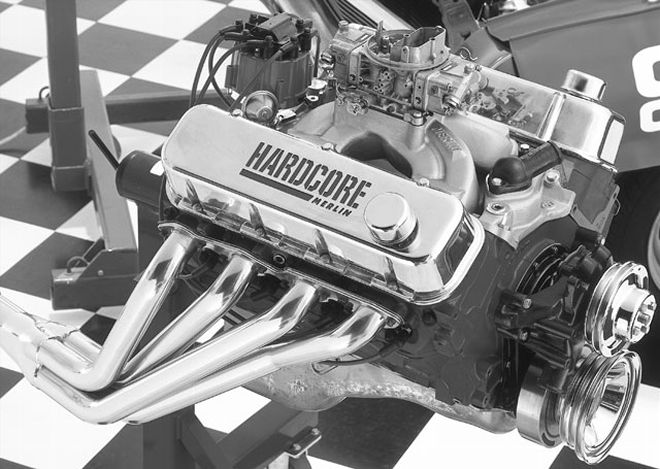
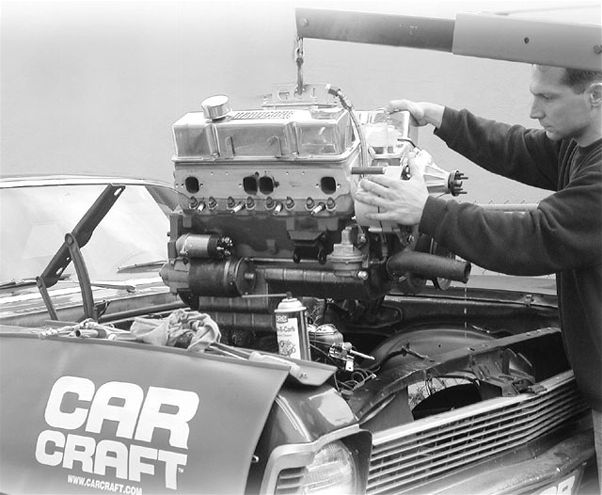
Big-block or small-block--pick your poison. This argument is as old as the hills and one that often crops up and divides the Car Craft staff. "Big-blocks make more power," claim the loyal big-inch contingent. "Small-blocks are much lighter than their big brothers; big-blocks make more torque, and more torque means more traction problems," counter the small-block loyalists. "But torque moves the car," say the big-block fans. All things being equal, a big-block will usually make more power and torque, but at what cost? The small-block usually gets the nod for lower cost, easier packaging, and good output per dollar. However, big-inch small-blocks are saddled with small-block-sized cylinder heads, and even marginal big-block heads will normally flow more air. You can't beat the appeal of a fat Rat nestled between your fenderwells, but whipping up on a big-block with a small-block means major bragging rights. And so it goes.
So, we decided to use our latest automotive acquisition as a testbed to revisit this oft-heated argument. We got our hands on two Bill Mitchell Hardcore Racing crate motors: a 427-inch small-block and a 509-inch big-block. The SuperNova's 383 was temporarily tossed aside and in its place went the 427-inch small-block crate motor to begin Phase One of our test. Phase Two was accomplished by shoehorning the 509-inch Rat into the poor SuperNova for more dragstrip thrashing. Will this issue be settled once and for all? You be the judge.

What You'll Need
While they come fairly complete and already broken in on the dyno, there are still some items you will need before you can install and run your 427 or 509 crate motor.
* Flexplate: Ours was purchased from our local parts emporium; both engines take a neutral-balance flexplate
* Headers: Hedman 1 ¾-inch units for the Mouse, 2-inch units for the Rat
* Water pump: We chose to use long-style pumps for both engines, with an aluminum unit on the Mouse and an iron one for the Rat
* Pulleys: Classic Industries supplied the repro '69 396ci 6 ¾-inch two-groove crank pulley intended for use with the long water pump. Note: Typical aftermarket big-block 7 ¾-inch-diameter pulleys will barely clear the crossmember, making belt changes difficult.
* Alternator bracket: Alan Grove Components provided trick mid-mount long-pump alternator brackets for both engines
* Fuel pump: Bill Mitchell crate motors have provisions for using mechanical fuel pumps; we used Barry Grant Superspeedway mechanical pumps on both
* Dipstick: Taiwan-chrome from our local speed shop in Glendale, CA
Hardcore 427 Specs
Displacement: 427 ci
Bore/stroke: 4.125x4.000 inches
Compression: 10.0:1
Weight: 435 pounds
Cylinder heads: Aluminum Motown 220cc (PN 024150A-2), 64cc angle plug
Valves: Manley 2.080/1.600-inch intake/exhaust
Head gaskets: Fel-Pro (PN 1004)
Balancer: Pro Race (PN 24265)
Carburetor: Hardcore 870-cfm Hi Flow (PN 217-25133)
Intake manifold: Edelbrock Super Victor (PN 2925)
Ignition: Hardcore HEI (PN 216-85306)
Wires: Taylor 8mm (under header)
Cam: Crane hydraulic 244/252 degrees duration at 0.050-inch lift, 0.515/0.525-inch lift
Valvesprings: 1.437-inch diameter dual
Rocker arms: 1.5 ratio, Harland Sharp 0.150 offset rollers (intake)
Pushrods: Manley 4340 one-piece
Lifters: Speed Pro hydraulic
Timing chain: Manley Street Roller (PN 73163)
Valve covers: Motown chrome (PN 070721)
Oil pan: Milodon Street/Strip (PN 30908)
Oil pump: Federal-Mogul
Block: Motown 9.025/4.125
Crankshaft: Scat/Eagle 4340 4.00-inch stroke
Connecting rods: Eagle H-beam 6.0-inch with L-19 bolts
Pistons: JE/Wiseco forged -20cc reverse dome
Rings: JE moly 1/16, 1/16, 3/16 standard tension
Bearings: Clevite H-series
Balance: Internal
Cost: $8,995.00
Warranty: Two-year limited
The Mouse That Roared
Bill Mitchell Hardcore Racing's 427ci Mouse features pump-gas friendly compression, aluminum heads, and a svelte weight of only 435 pounds. Producing more than 540 hp and 523 lb-ft of torque (see "427 Dyno-Test" sidebar), this is a stout package indeed. Horsepower peaked at a low-stress (for a small-block) 6,000 rpm. The big-inch Mouse produced 1.24 horses per pound while the big-block was only able to muster 0.95 horses per pound. On paper, the Mouse looks better, but will torque tip the scales in the favor of the big-block? More important is the power-to-weight ratio when installed in the vehicle. The Mouse-equipped SuperNova features a power-to-weight ratio of 6.14 pounds per horsepower. With the 509 nestled between its fenders, SuperNova sported a superhero-like 5.76 pounds per horsepower.
Hardcore 509 Specs
Displacement: 509 ci
Bore x stroke: 4.500x4.000 inches
Compression: 9.5:1
Weight: 640 pounds
Cylinder heads: Iron Merlin 345 cc (PN 030630A-2), 119 cc
Valves: Manley 2.300/1.880-inch intake/exhaust
Head gaskets: Fel-Pro (PN 1017-1)
Balancer: Pro Race (PN 24264)
Carburetor: Hardcore 870 Hi Flow (PN 217-25133)
Intake manifold: Merlin single-plane (PN 063030)
Ignition: Hardcore HEI (PN 216-85306)
Wires: Taylor/Merlin 8mm
Cam: Crane hydraulic, 236/246 degrees duration at 0.050-inch lift, 0.553/0.571-inch lift
Valvesprings: 1.550-inch diameter dual
Rocker arms: 1.7:1 Crane/Hardcore roller rockers
Pushrods: Manley 4340 one-piece
Lifters: Speed Pro hydraulic
Timing chain: Manley Street Roller (PN 73168)
Valve covers: Merlin chrome (PN 070741)
Oil pan: Milodon (PN 30710)
Oil pump: Federal-Mogul
Block: Merlin II 9.800
Crankshaft: Scat/Eagle 4130 4.000
Connecting rods: Manley
I-beam 6.385
Pistons: JE forged 12cc dome
Rings: JE moly 1/16, 1/16, 3/16 standard tension
Bearings: Clevite H-series
Balance: Internal
Cost: $7,495.00
Warranty: Two-year limited
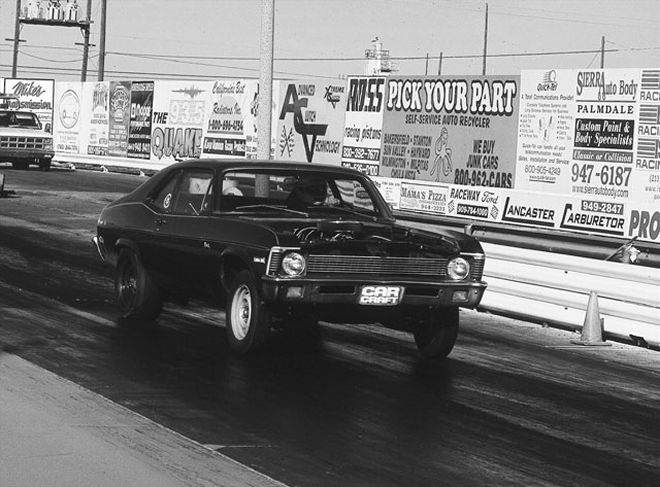
Rabid Rat
The 509 inches of a Rat motor are hard to ignore. The big-block slipped between the framerails of SuperNova without any fanfare, thanks in part to the fact that Novas could be purchased in '69 and '70 with factory-installed 396-inch big-block power, so repro parts are available for the swap. The only major changes needed were the frame mounts and motor mounts, which we procured from Chevy 2 Only, and headers. One should also consider a cowl hood when running a big-block in a Nova, as the hood-to-carburetor clearance is minimal with a tall single-plane intake. The factory used a low-profile dual-plane in stock applications. As such, we were unable to run an air-cleaner assembly. Our 509 featured iron heads and an iron water pump, bringing the fat Rat up to a portly 640 pounds--a hair more than 200 pounds over the mighty Mouse.
The Showdown
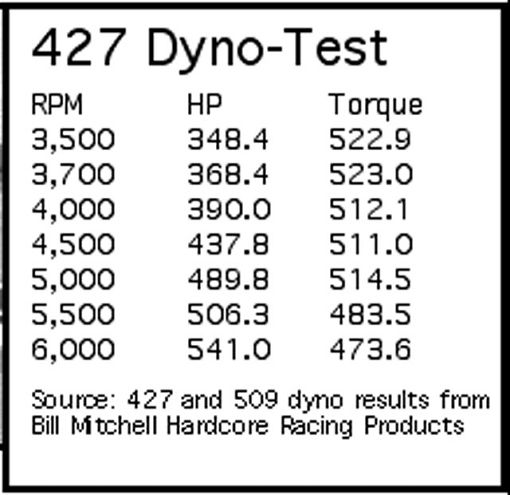
After the smoke of bench racing, theorizing, and wishful thinking cleared, we were left with the one measurement that counts: the drag test. The proverbial bottom line. Just the car versus the Chrondek. No excuses, please. First we went to the track packing the "little" 427. Come to think of it, we drove the Nova all the way to L.A. County Raceway (LACR). That we were able to drive the SuperNova over 60 miles to LACR speaks volumes. This healthy engine not only provides gobs of torque and power, but it wasn't even remotely objectionable on the somewhat long haul to the high desert of Palmdale, California, or in around-town traffic.
Our first pass after unloading the contents of the trunk, swapping radials to slicks, and giving the Nova a brief cool-down netted us an uncorrected (LACR is 2,700-feet above sea level) 11.94 at 111.57. Things looked promising. Our best pass of the day was an 11.76 at 113 mph with a 1.59 60-foot time. The added torque of the big-inch small-block obviously agreed with the 60-foot clocks. Despite the great performance, would it be enough to stave off the Rat motor? We would soon find out.
A couple weeks later we were back at LACR, armed with the 509-inch big-block nestled snugly between the fenders of project SuperNova. We towed it for this outing as we were pressed for time and didn't have the opportunity to perform any shakedown on the street. In hindsight, we fully believe that the 509 would have provided trouble-free street manners, although we will need to step up the cooling system with a bigger radiator. We reused the Turbo 350 and torque converter of the previous small-block drag test in order to keep as many constants as possible. We knew that the 427-inch small-block was a solid 11-second performer, but would the added torque, horsepower, and weight prove significant? We were about to find out.
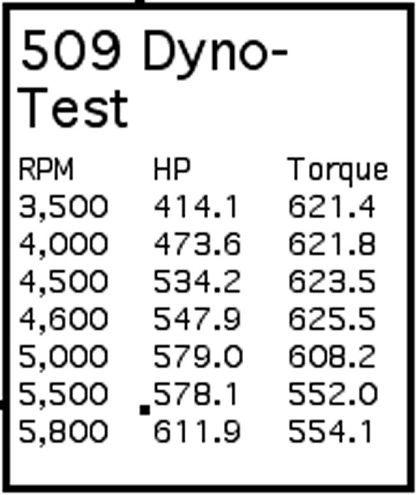
The first pass off of the trailer netted us a less-than-spectacular 12.55 at 106.35 mph. Thinking this was a fluke, we backed that pass up with a 12.43 at 106.16 mph. Traction was good, but the SuperNova just wasn't pulling. We decided to remove the hood as it was sitting very close to the top of the carburetor, and we added an air cleaner in order to direct air into the carb (and obviously to keep damaging dirt particles out). The Nova promptly responded with an 11.92 at 111.62. Now we were getting somewhere. Fiddling with float levels and launch rpm rewarded us with a best e.t. of 11.60 at 114.25. It is important to note that the day of testing was considerably hotter than when the previous small-block testing was accomplished, and the SuperNova's cooling system proved inadequate for the big-block. Our best time resulted when the car was given a full 30 minutes to cool down.
Excuse Time
So, what did we learn? Many things that look good on paper don't necessarily work out the same way in practice. When examining dyno curves, power-to-weight ratios, and such, the big-block wins hands down. For a balanced package with good power and low weight, the small-block is the weapon of choice. In all fairness, weather plays a significant role at the dragstrip. Yet despite less-than-favorable temps and air quality, the Rat took top honors at the track.

If the heat claimed a couple of tenths, we're looking at a very-low-11-second piece at sea level. Of course, once you're in the low-11-second range, high-10s are right around the corner. Is there more left in the big-block? We think so. In fact, we'll be playing more with the Rat in an effort to further optimize the combination. We'll also be replacing the much-abused Turbo 350 for a tricked-out Turbo 400 and a converter better suited to the combination.
We also learned that Bill Mitchell offers some kick-ass crate motors that take the guess-work out of picking a combination for your street/strip bruiser. You simply need to figure out your budget and how fast you want to go, and let Bill Mitchell sort out the rest.
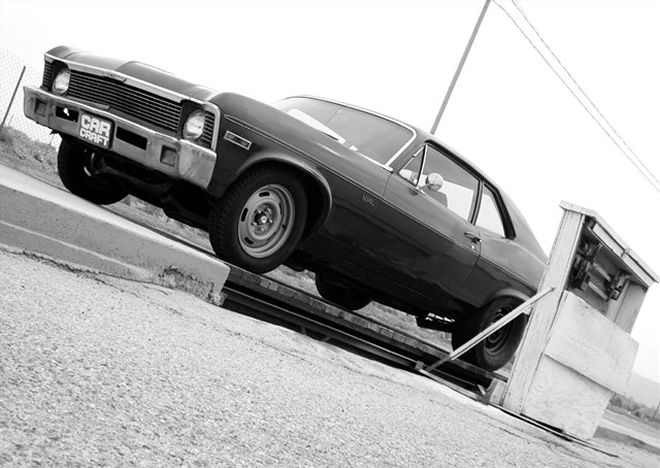 Weight is one of the main premises of the small-block versus big-block argument. The small-block weighed in at 3,325 pounds with driver, and the big-block tipped the scales at just over 3,500.
Weight is one of the main premises of the small-block versus big-block argument. The small-block weighed in at 3,325 pounds with driver, and the big-block tipped the scales at just over 3,500.
It's also time for us to add a rollbar and some basic safety equipment as the little SuperNova is growing up in a hurry. So stay tuned--this debate is far from over.
The Combo
* MT ET Drag slicks, 28x9.0-15
* Dana 60 with 4.10 Detroit Locker
* Turbo 350 with B&M Holeshot 10-inch 3,000-stall converter
* Hedman 1 ¾-inch headers on small-block
* Hedman 2-inch headers on big-block
* 3-inch exhaust with Dynomax Ultra-Flow mufflers
Note: Both engines used supplied carbs with no jetting changes. Both engines also came with HEI and pre-cut wires, but we used our MSD Ready-to-Run distributor in both cases.